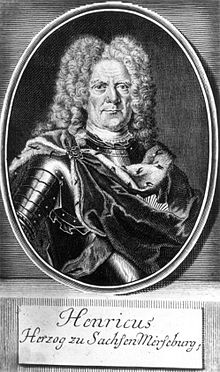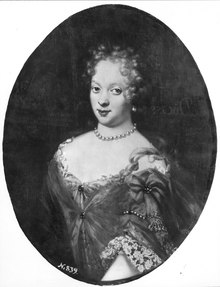Heinrich (Saxony-Merseburg)


Heinrich von Sachsen-Merseburg (born September 2, 1661 in Merseburg , † July 28, 1738 in Dobrilugk ) was a member of a sideline of the Albertine Wettins and fifth and last duke of the Saxon secondary school principality of Saxony-Merseburg .
family
Heinrich was the sixth son of Duke Christian I of Saxony-Merseburg and his wife Christiana , a daughter of Duke Philip of Schleswig-Holstein-Sonderburg-Glücksburg .
Life
Government in Spremberg
In order to be able to look after his three sons who were born later, Duke Christian I assigned them their own small domains as appanages during his lifetime , which, however, remained dependent on the main Merseburg line and whose sovereign rights were severely limited. In the course of this distribution, Heinrich received the Lusatian town of Spremberg as his own residence, thereby establishing the Sachsen-Merseburg-Spremberg line.
Heinrich's reign led to an extraordinary bloom in Spremberg, so in 1694 he had Spremberg Castle expanded into his summer residence. Two stately three-storey wings were built in the east and west, which were connected by a wooden gallery on the courtyard side, and the tower was provided with a tent roof.
Furthermore, he had a pleasure garden built and enjoyed hunting. His preferred hunting area was Heinrichsfeld, which was later named after him - today a district of Spremberg.
In addition, with his support, the city was rebuilt after the great fire of July 30, 1705. For his craftsmen he granted privileges that led to the flourishing of crafts and trade. He is also considered a great promoter of culture; so he appointed Johann Theodor Roemhildt in 1726 as his court conductor and later employed him in Merseburg. He had a cabinet of medals designed by the sculptor Johann Michael Hoppenhaupt , which today is the only original piece of furniture in the Museum of Cultural History at Merseburg Castle .
The extinction of the main line brings Heinrich to the throne
Since the last duke of the Merseburg main line, Heinrich's nephew Moritz Wilhelm , had no male descendants and the only remaining heir, Hereditary Prince Friedrich Erdmann , had already died, the duchy fell to the now 69-year-old Heinrich on April 21, 1731 .
He continued the economy and culture-friendly reign of his nephew. In 1735 the Duke's pavilion was built in Bad Lauchstädt and in 1738 the so-called Upper Water Art, a baroque fountain and farmhouse in Merseburg-Oberaltenburg, was built by its sculptor and architect Johann Michael Hoppenhaupt . He had the Fuhnedamm of his father Christian I, located between Zörbig and the Anhalt town of Radegast , repaired. In Heinrich's honor, a commemorative plaque was therefore attached to the Theurer Christian road construction monument .
Death and burial
Duke Heinrich died on July 28, 1738 at the age of 76 at Doberlug Castle and was buried in a pewter coffin in the princely crypt of Merseburg Cathedral . Since neither he nor any other male member of the branch line had left surviving male descendants, the line was considered to have been extinct in the male line and the Merseburg secondary school fell back to Electoral Saxony .
Marriage and offspring
His only marriage was on March 29, 1692 in Güstrow with Elisabeth von Mecklenburg-Güstrow , the daughter of Gustav Adolf , Duke of Mecklenburg-Güstrow from his marriage to Magdalene Sibylle von Schleswig-Holstein-Gottorf .
He had the following children with his wife:
- Moritz (born October 29, 1694 in Spremberg, † April 11, 1695 in Spremberg), Hereditary Prince of Saxony-Merseburg-Spremberg
- Christiane Friederike (born May 17, 1697 in Spremberg, † August 21, 1722 in Spremberg), Princess of Saxony-Merseburg-Spremberg
- Gustava Magdalena (born October 2, 1699 in Spremberg, † October 3, 1699 in Spremberg), Princess of Saxony-Merseburg-Spremberg
Web links as sources
- Publications from and about Heinrich im VD 17 .
- Pierer's Universal-Lexikon, Altenburg 1857-1865, Volume 14, p. 685
- Johann Hübners ... three hundred and three and thirty genealogical tables, tab. 170
- Heinrich Herzog von Sachsen-Spremberg on thepeerage.com , accessed on September 18, 2016.
| predecessor | Office | successor |
|---|---|---|
| Christian I. |
Duke of Saxony-Merseburg-Spremberg around 1694 - 1731 |
risen in the duchy of Saxony-Merseburg |
| predecessor | Office | successor |
|---|---|---|
| Moritz Wilhelm |
Duke of Saxe-Merseburg 1731 - 1738 |
incorporated into the Electorate of Saxony ( Friedrich August II. , Elector of Saxony ) |
| personal data | |
|---|---|
| SURNAME | Heinrich |
| ALTERNATIVE NAMES | Heinrich von Spremberg |
| BRIEF DESCRIPTION | Duke of Saxe-Merseburg-Spremberg, Duke of Saxe-Merseburg |
| DATE OF BIRTH | September 2, 1661 |
| PLACE OF BIRTH | Merseburg |
| DATE OF DEATH | July 28, 1738 |
| Place of death | Dobrilugk |

